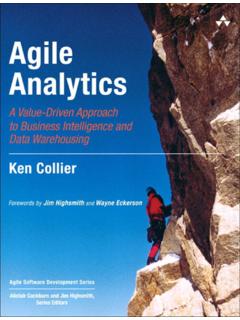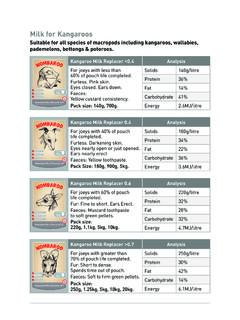Transcription of THE SCRUM IELD UIDE - pearsoncmg.com
1 THE SCRUM FIELD GUIDE. The agile Software Development Series Alistair Cockburn and Jim Highsmith, Series Editors Visit for a complete list of available publications. gile software development centers on four values, which are identified A in the agile Alliance's Manifesto*: 1. Individuals and interactions over processes and tools 2. Working software over comprehensive documentation 3. Customer collaboration over contract negotiation 4. Responding to change over following a plan The development of agile software requires innovation and responsiveness, based on generating and sharing knowledge within a development team and with the customer.
2 agile software developers draw on the strengths of customers, users, and developers to find just enough process to balance quality and agility. The books in The agile Software Development Series focus on sharing the experiences of such agile developers. Individual books address individual techniques (such as Use Cases), group techniques (such as collaborative decision making), and proven solutions to different problems from a variety of organizational cultures. The result is a core of agile best practices that will enrich your experiences and improve your work.
3 * 2001, Authors of the agile Manifesto THE SCRUM FIELD GUIDE. PRACTICAL ADVICE FOR YOUR FIRST YEAR. MITCH LACEY. Upper Saddle River, NJ Boston Indianapolis San Francisco New York Toronto Montreal London Munich Paris Madrid Capetown Sydney Tokyo Singapore Mexico City Many of the designations used by manufacturers and sellers to distinguish their products are claimed as trademarks. Where those designations appear in this book, and the publisher was aware of a trade- mark claim, the designations have been printed with initial capital letters or in all capitals.
4 The author and publisher have taken care in the preparation of this book, but make no expressed or implied warranty of any kind and assume no responsibility for errors or omissions. No liability is assumed for incidental or consequential damages in connection with or arising out of the use of the information or programs contained herein. The publisher offers excellent discounts on this book when ordered in quantity for bulk purchases or special sales, which may include electronic versions and/or custom covers and content particular to your business, training goals, marketing focus, and branding interests.
5 For more information, please contact: Corporate and Government Sales (800) 382-3419. For sales outside the United States please contact: International Sales Visit us on the Web: Library of Congress Cataloging-in-Publication Data Lacey, Mitch. The SCRUM field guide : practical advice for your first year / Mitch Lacey. 1st ed. p. cm. Includes index. ISBN 0-321-55415-9 (pbk. : alk. paper). 1. agile software development. 2. SCRUM (Computer software development). I. Title. 2012. dc23 2011040008. Copyright 2012 Mitchell G. Lacey All rights reserved.
6 Printed in the United States of America. This publication is protected by copyright, and permission must be obtained from the publisher prior to any prohibited reproduction, storage in a retrieval system, or transmission in any form or by any means, electronic, mechanical, photocopying, recording, or likewise. To obtain permission to use material from this work, please submit a written request to Pearson Education, Inc., Permissions Department, One Lake Street, Upper Saddle River, New Jersey 07458, or you may fax your request to (201) 236-3290.
7 ISBN-13: 978-0-321-55415-4. ISBN-10: 0-321-55415-9. Text printed in the United States on recycled paper at RR Donnelley in Crawfordsville, Indiana. Second printing, October 2013. This book is dedicated to two teams; The first team is my family. My wife, Bernice, and my kids, Ashley, Carter, and Emma without their support and constantly asking are you done yet? this book would not be here. They kept me focused and supported me throughout. The second team is the group of guys from the Falcon project while at Microsoft. John Boal, Donavan Hoepcke, Bart Hsu, Mike Puleio, Mon Leelaphisut, and Michael Corrigan (our boss), thank you for having the courage to leap with me.
8 You guys made this book a reality. This page intentionally left blank CONTENTS. Foreword by Jim Highsmith xix Foreword by Jeff Sutherland xxi Preface xxv Acknowledgments xxix About the Author xxxi Chapter 1 SCRUM : Simple, Not Easy 1. The Story 1. SCRUM 6. What Is SCRUM ? 6. Implementing SCRUM 7. When Is SCRUM Right for Me? 13. Change Is Hard 14. Keys to Success 17. References 18. Part I Getting Prepared 19. Chapter 2 Getting People On Board 21. The Story 21. The Model 27. Change Takes Time 28. Establish a Sense of Urgency 28. Form a Powerful Guiding Coalition 29.
9 Create a Vision/Paint a Picture of the Future 29. Communicate the Vision 29. vii viii Contents Empower Others to Act on the Vision 30. Plan for and Create Short-Term Wins 31. Consolidate Improvements 31. Institutionalize New Approaches 31. Keys to Success 31. Be Patient 32. Provide Information 32. References 32. Chapter 3 Using Team Consultants to Optimize Team Performance 33. The Story 33. The Model 37. Establishing a Team Consultant Pool 38. Building Your Team 40. Keys to Success 45. Accountability 45. Experiment 46. Be Cautious of Overloading 47.
10 Plan for Potential Downtime 47. Team Consultants Are Not a Replacement for Dedicated Teams 47. References 48. Works Consulted 48. Chapter 4 Determining Team Velocity 49. The Story 49. The Model 54. The Problem with Historical Data 55. Shedding Light on Blind Estimation 56. Wait and See (Use Real Data) 59. Truncated Data Collection 62. Keys to Success 63. References 65. Chapter 5 Implementing the SCRUM Roles 67. The Story 67. The Model 70. Choosing Roles 72. Mixing Roles 73. When, Not If, You Decide to Mix Roles Anyway 75. Keys to Success 76. Contents ix Chapter 6 Determining Sprint Length 77.















